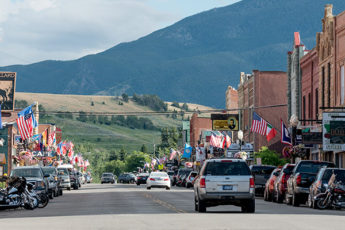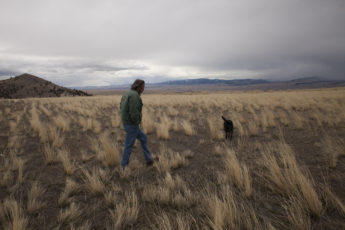Feature photo of organic potatoes grown in the Gallatin Valley.
Goals: Buy Local Food,
Anchor Uptown Businesses
By Renata Birkenbuel
UPDATES: Butte Food Co-Op Community Interest Survey is available online: https://www.surveymonkey.com/r/buttefoodcoop
The newly formed organization’s new website: https://buttefoodcoop.wordpress.com/
Since a wide array of Butte residents turned out in force for an initial informational meeting to create a potential food co-operative in ever-changing Uptown, local community leaders have already taken action.
Dave Scott, a Whitehall sheep farmer, Montana Highland Lamb owner and livestock specialist for the National Center for Appropriate Technology in Butte, enthusiastically told the food enthusiasts he would love to market to the Mining City. He already sells lamb via direct marketing to the Bozeman Food Co-op.
“I like connecting farmers to institutions where people can get good food to eat,” said Scott, adding: “To connect with individual consumers is primary, so I hope this co-cop gets off the ground.”
Donors have led the charge, as Missoula Federal Credit Union donated $2,500 and Knute Oass gave $100 in seed money while challenging others to do the same. Headwaters RC&D, 65 E. Broadway in Butte, is taking donations.
Leo Prigge of the family-owned Prigge & Otten PC Certified Public Accountants has volunteered to chair a brand-spanking new fundraising committee.
The Butte Food Co-Op Working Group on Facebook is soliciting members.
Initially, on June 10, a groundswell of interested potential members and eager future customers numbered about 175, cramming the Thornton Building ballroom after Hennessey’s Market, located on the ground floor of the stylishly revamped Sears Building, closed recently on East Granite Street. The grocery closure prompted many to converge and hear options for establishing a Butte food co-op.
The business model for a Butte food co-op is wide open – and up to the eventual membership, Marilyn Besich, Montana Cooperative Development Center program director, told the packed house in a quick mass tutorial.
Types of co-ops, Besich said, include consumer-owned, worker-owned or independent-entity-owned via group purchasing or shared services. A co-op can be centralized or federated.
Its functions can include one or more of the following: marketing of agricultural products, farm and retail purchasing or a wide range of service cooperatives. A co-op, she said can even comprise a bunch of other co-ops.
“The co-op can be anything it decides to be,” added Steve Thompson, recently hired executive director of National Center for Appropriate Technology, a green technology, food sustainability, agricultural leader located in Butte. “So don’t limit your thinking about what’s possible.”
Russell O’Leary, 31, a Butte native and a real estate professional who lives Uptown, is a serious supporter who met like-minded souls again last week to brainstorm various aspects of building a food co-op: vision, guiding principles, financials and talent or membership make-up. He is especially interested in the food source for the proposed co-op – and the convenience.
“I don’t always want to go to Safeway,” O’Leary said. “It’s really the only option for us. I would prefer to have something closer.”
Accessibility and walkability are two features that draw customers to a food co-op. Hennessey Market provided both for regulars.
“That was always the appeal of Hennessey’s,” added O’Leary. “One of the reasons I support (a Butte food co-op) is that we really do need an anchor store in Uptown Butte. You need a main attraction to get people out of their cars and walking down the street. Getting a grocery store is one of the options.”
A Montana State University graduate, O’Leary frequently shopped at the Bozeman Community Food Co-op, founded in 1979 in a tiny house. It has since greatly expanded and turned into a rousing success story.
Photo source: courtesy of Montana Cooperative Development Center and created by Donnie Harvell.
To see a larger image, click HERE for the Montana Cooperative Development Center’s annual report.
Other thriving Montana food co-ops exist in one form or another: The Inconvenient Store in Neihart, the Fresh Start Grocery Co-op in Geraldine and Big Flat Grocery in Turner on the Hi-Line. Butte is not a rural community, but Thompson considers the Mining City “a food desert” ripe for such a co-op.
Among standard food co-op goals: source food as close to home as possible and help reduce trucking in less fresh, more expensive food from across the country to stock the shelves.
“There’s always going to be those baseline staple foods that come from far away,” O’Leary said, “but having produce that’s closer to home and trying to support and source food from farmers who are nearby would be a goal that everybody would support.”
Photos by Amanda Garant.
Butte has two Safeway grocery stories – one on Front Street about a mile south of Uptown and another across town near Harrison Avenue about 2.5 miles away. A closer chain, Stokes, closed recently on Harrison in a building that once housed Albertson’s. Otherwise, Hennessey’s Market – a high-end, produce-and-bulk-heavy grocery with less-than-everyday prices – proved unable to overcome persistent food distributor and delivery problems.
Still, planted visibly around the corner from the Hotel Finlen, Uptown Café and other thriving Uptown businesses, Hennessey’s remained a popular last-minute grocery and deli, especially for the business lunch crowd. Otherwise, its secondary sales languished, according to former store manager Rob Hedval.
Thompson and meeting organizer Julie Jaksha, Headwaters RC&D director in Butte, emphasized the need for an anchor store in the Uptown area, where seemingly rock-solid boutiques, niche businesses and restaurants come and go with regularity due to Butte’s varying economic uncertainty and persistent jobs insecurity.
“A vibrant downtown really needs to have an anchor store that helps drive traffic … that’s a basic tenet,” said Thompson, who moved from Whitefish to take the NCAT helm. “An anchor store can really help revitalize a community.”
When Hennessey’s Market opened in 2010, it was an urban showcase visible to all Montana Folk Festival attendees who packed in the Granite Street Stage and bypassed the grocery’s glassed-in fresh produce section while en route to other music venues. It was a natural draw, too, during the traditional St. Patrick’s Day celebration in Uptown Butte, the annual An Ri Ra Montana Irish Festival and the now-defunct Evel Knievel Days.
O’Leary worries about walk-by traffic missing out this year.
“The space within the old Hennessey building is a key space that needs to be filled,” he said. “It’s got a pretty big void right at the moment. To me, that’s a pretty key spot because of proximity to the festivals. The eastern part of Uptown is where a lot of the cool old buildings are. Visitors need a quick bite to eat and buy some beer. I think it’s really a bummer that people will walk by there during the festival this year.”
However, stalwarts like the M&M Bar and Grill, Uptown Café, Metals Bank Grill and most recently 5518 Designs, Mongolian Grill, Butte Stuff, Beautiful Butte and Beyond, Cavanaugh’s County Celtic and others somehow maintain a solid foothold and seem to thrive economically.
One exception to the boom-or-bust pattern among some start-ups is the Dancing Rainbow Natural Grocery, which has been in business for 34 Steady Eddy years. Owner Judith Duryea is thrilled that Butte-ites want to create their own membership-driven food co-op.
“This is a great turnout – a huge crowd,” she told the assembled. “It’s awesome. It’s overwhelming.”
When Hennessey’s went under, it affected Duryea deeply.
“It broke my heart because I hate to see any business go belly-up,” she said, reminding the crowd that Dancing Rainbow opened in 1985. But Butte is primed for a food co-op.
“I think there is great opportunity for us to thrive,” she said.
Besich, a Butte native who previously taught business at Great Falls College Montana State University –pointed to the successful rural food co-ops, which pick up the slack in response to “market failure or when privately-held operations simply cannot survive.”
Butte organizers have already embraced the co-ops-helping-co-ops strategy, as Paul Herendeen, market development director for Missoula Federal Credit Union raves:
“Projects like this one, that build vibrant, thriving communities, are exactly the kind that we want to support. People in Butte clearly see a lot of potential here. So do we, and we’re ready to help make it happen.”
Butte once had a 30-member buying club that ordered food from a UNFI wholesale and bulk foods catalogue until the food co-op lost its retail meeting space. The group existed for a few years and disbanded about 12 years ago, said former member Lori Stiffler.
If recent turn-out is any indication for the bigger, more ambitious Butte food co-op initiative, then Butte may some day satisfy all players: members, consumers, producers and visitors.
“To me, that’s the appeal of a co-op – for members to guide the direction of the co-op and the food that is available,” added O’Leary.
-By Renata Birkenbuel.
Updated June 25, 2019 to include a map of cooperatives throughout the state.
Got something to say to Prairie Populist? Send news tips, story ideas and comments to [email protected]. If you have something to submit, or an idea for a story you’d like to write for us, check out our Submission Guidelines here.


